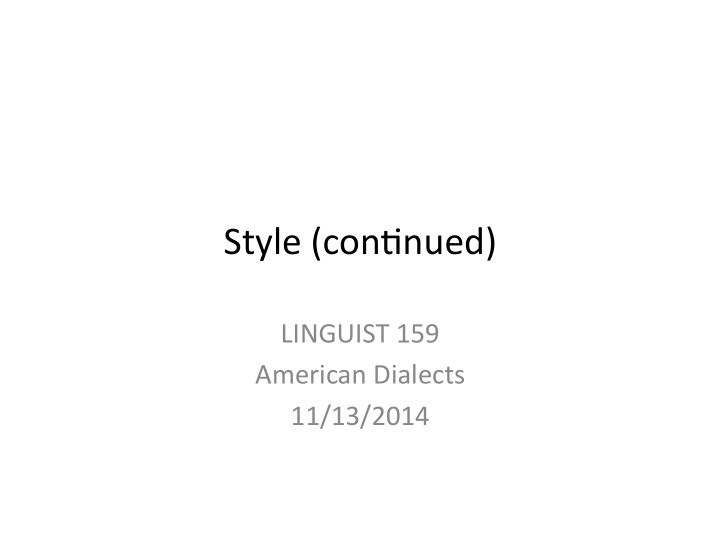



Style ¡(con+nued) ¡ LINGUIST ¡159 ¡ American ¡Dialects ¡ 11/13/2014 ¡
Style ¡in ¡the ¡third ¡wave ¡ ¡“Style ¡are ¡ performa(ve … ¡style ¡ brings ¡about ¡ meaning, ¡it ¡doesn’t ¡just ¡reflect ¡already-‑ exis+ng ¡meaning.” ¡ -‑the ¡Half ¡Moon ¡Bay ¡Style ¡Collec+ve, ¡ ¡ “The ¡elements ¡of ¡style” ¡
Performa+vity ¡ • J.L. ¡Aus(n ¡– ¡ Speech ¡Act ¡Theory ¡ — ¡ ¡performa+ve ¡ u[erance ¡accomplishes ¡some ¡ac+on ¡ – “I ¡name ¡the ¡ship ¡‘Queen ¡Elizabeth’.” ¡ • Judith ¡Butler ¡ – ¡performa+ve ¡u[erance ¡puts ¡forth ¡ acts ¡of ¡iden+ty ¡(“doing” ¡a ¡style ¡or ¡social ¡type) ¡ – “Gender ¡is ¡always ¡a ¡doing, ¡though ¡not ¡a ¡doing ¡by ¡a ¡ subject ¡who ¡might ¡be ¡said ¡to ¡pre-‑exist ¡the ¡deed” ¡ ¡ ¡—Butler, ¡ Gender ¡Trouble ¡ (1993) ¡ • Performance ¡speech ¡(as ¡a ¡register), ¡or ¡“high ¡ performance” ¡
Podesva ¡(2001) ¡ • Which ¡variable ¡(or ¡system ¡of ¡variables) ¡is ¡ inves+gated? ¡ • What ¡is ¡the ¡research ¡ques+on? ¡ • Where ¡was ¡the ¡research ¡conducted? ¡ • Who ¡were ¡the ¡speakers? ¡ • How ¡was ¡data ¡elicited? ¡
Podesva ¡(2007) ¡ Linguis+c ¡styles ¡derive ¡meaning ¡by ¡ – Assembling ¡the ¡social ¡meanings ¡of ¡their ¡ component ¡linguis+c ¡features ¡ – Contras+ng ¡with ¡other ¡linguis+c ¡styles ¡ – Occurring ¡in ¡specific ¡interac+onal ¡moments ¡
Podesva ¡(2007) ¡ • What ¡are ¡the ¡ways ¡we ¡can ¡infer ¡social ¡ meanings ¡of ¡linguis+c ¡features? ¡ • How ¡does ¡Podesva ¡use ¡discourse ¡context ¡to ¡ infer ¡social ¡meaning? ¡Why ¡is ¡this ¡strategy ¡ useful? ¡ • What ¡is ¡the ¡rela+onship ¡between ¡styles ¡and ¡ personas? ¡Why ¡is ¡this ¡useful? ¡
Podesva ¡(2007) ¡
Podesva ¡(2007) ¡
Podesva ¡(2007) ¡ • How ¡would ¡we ¡situate ¡these ¡findings ¡in ¡the ¡ a[en+on ¡to ¡speech ¡model? ¡ • How ¡would ¡we ¡situate ¡these ¡findings ¡in ¡the ¡ audience ¡design ¡model? ¡The ¡referee ¡design ¡ model? ¡ • Does ¡Heath ¡speak ¡his ¡own ¡dialect? ¡Mul+ple ¡ dialects? ¡
Performance ¡ • Performances ¡used ¡to ¡examine ¡ideological ¡ connec+ons ¡between ¡language ¡and ¡par+cular ¡ social ¡types ¡ (e.g. ¡Schilling-‑Estes ¡1998; ¡Coupland ¡2001; ¡ Chun ¡2004; ¡Johnstone ¡2011; ¡Carmichael ¡2013) ¡ • Linguis+c ¡styliza+on ¡in ¡performances ¡viewed ¡ as ¡reflec+ng ¡most ¡emblema+c ¡features ¡ connected ¡with ¡these ¡social ¡types ¡— ¡features ¡ that ¡are ¡ enregistered ¡
Performance ¡ • Many ¡studies ¡of ¡performance ¡have ¡examined ¡ linguis+c ¡performances ¡of ¡social ¡types ¡ connected ¡to ¡ place ¡ (e.g. ¡Schilling-‑Estes ¡1998; ¡Coupland ¡ 2001; ¡Johnstone ¡2011; ¡Carmichael ¡2013) ¡ • Dialect ¡styliza+on ¡– ¡connec+on ¡between ¡ dialect ¡features ¡and ¡ place ¡as ¡mediated ¡by ¡ roles, ¡stances, ¡and ¡social ¡types ¡associated ¡with ¡ that ¡place ¡
Schilling-‑Estes ¡(2001) ¡ • Which ¡variable ¡(or ¡system ¡of ¡variables) ¡is ¡ inves+gated? ¡ • What ¡is ¡the ¡research ¡ques+on? ¡ • Where ¡was ¡the ¡research ¡conducted? ¡ • Who ¡were ¡the ¡speakers? ¡ • How ¡was ¡data ¡elicited? ¡
Schilling-‑Estes ¡(1998) ¡ /oy/ ¡
Schilling-‑Estes ¡(1998) ¡ • What ¡dimensions ¡of ¡/ay/ ¡does ¡Rex ¡shil ¡upon? ¡ Which ¡ones ¡are ¡more ¡influenced ¡by ¡style-‑ shils? ¡Less ¡influenced? ¡ • What ¡does ¡this ¡tell ¡you ¡about ¡how ¡Rex ¡(and ¡ others) ¡perceive ¡about ¡Ocracoke ¡English? ¡ • What ¡is ¡the ¡social ¡meaning ¡of ¡Ocracoke ¡/ay/? ¡ • How ¡does ¡this ¡relate ¡to ¡a[en+on ¡to ¡speech ¡ (also ¡a ¡model ¡of ¡percep+on/evalua+on)? ¡
Schilling-‑Estes ¡(1998) ¡ • When ¡in ¡the ¡interview ¡context ¡does ¡Rex ¡shil ¡into ¡ his ¡performance ¡register? ¡Why? ¡How ¡do ¡we ¡ know? ¡ • How ¡can ¡we ¡situate ¡Rex’s ¡style-‑shiling ¡in ¡the ¡ audience ¡design ¡model? ¡The ¡referee ¡design ¡ model? ¡ • Does ¡Rex ¡speak ¡a ¡dialect? ¡Mul+ple ¡dialects? ¡ • Connec+on ¡between ¡dialects ¡and ¡specific ¡roles? ¡ Specific ¡personae? ¡ • Does ¡this ¡influence ¡how ¡you ¡think ¡of ¡regional ¡ dialects? ¡How? ¡
Performance ¡and ¡Performa+vity ¡-‑ ¡ Ques+ons ¡ • How ¡does ¡thinking ¡about ¡ performances ¡help ¡ us ¡understand ¡the ¡use ¡of ¡dialect ¡features? ¡ • Does ¡performance ¡always ¡run ¡counter ¡to ¡the ¡ a[en+on ¡to ¡speech ¡model? ¡The ¡audience ¡ design ¡model? ¡ • How ¡are ¡case ¡studies ¡of ¡one ¡speaker ¡useful ¡for ¡ us ¡in ¡thinking ¡about ¡dialects? ¡
Style ¡in ¡the ¡third ¡wave ¡-‑ ¡Ques+ons ¡ • Is ¡it ¡reasonable ¡to ¡say ¡that ¡every ¡single ¡ u[erance ¡of ¡a ¡variable ¡serves ¡a ¡purpose ¡for ¡ that ¡speaker ¡or ¡listener? ¡ • How ¡can ¡we ¡separate ¡uses ¡of ¡a ¡variable ¡that ¡ can ¡be ¡a[ributed ¡to ¡speaker ¡agency ¡versus ¡ linguis+c ¡rules/structure? ¡ • Which ¡types ¡of ¡social ¡meanings ¡are ¡primary? ¡ • How ¡does ¡social ¡meaning, ¡or ¡performa+vity, ¡ interact ¡with ¡consciousness? ¡
Recommend
More recommend